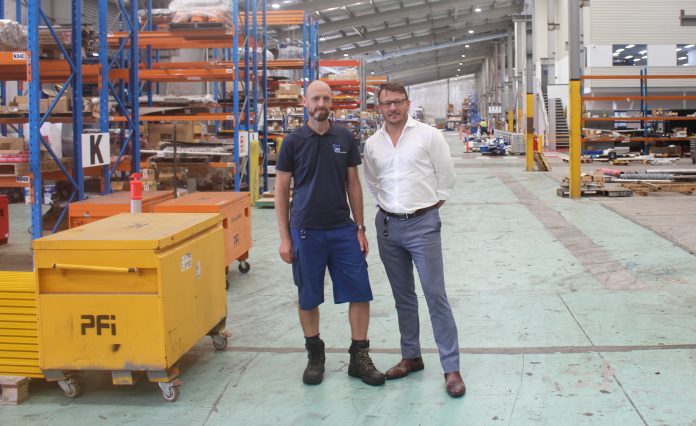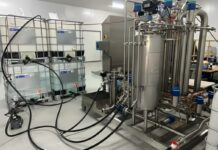
Media Release by Rockwell Automation
Queensland, Australia, has found a way to provide its customers with additional certainty, and reduced risk.
PFi employs Emulate3D™ by Rockwell Automation to create a digital twin, and completely visualise a new or upgraded plant, prior to the physical implementation.
Using 3D CAD modelling and integrated automation software, Emulate3D allows users to test the entire production process virtually, which helps to optimise the solution to save customers space, time, downtime, energy usage, and cost.
Gavin Dunwoodie, managing director, PFi, said, “More and more customers are asking for a simulation during the tender process, so if we can show exactly how well our solution will work, the ROI they are likely to achieve, and that we are meeting industry best practices, it gives us a real competitive advantage. We use Emulate3D software during the tender process to visualise customer operations using our machinery as part of our pitch.”
“Since incorporating Emulate3D into the process, we have seen a greater win rate, as customers can see the product working before they purchase. Yes, there are upfront costs, but they pay dividends as the customer is willing to pay a premium to see that the product produces needed, and often increased results,” added Dunwoodie.
PFi is a locally owned and operated business servicing the industrial sector. The company offers a full suite of in-house capabilities to support manufacturers with machine automation products, systems and solutions.
For brand new plants or automation retrofits, PFi uses Emulate3D by Rockwell Automation to showcase exactly how the new plant will run, down to the finest details.
“The details you can include in the software are incredible. If you’re handling frozen food, for example, we can simulate that melting could cause condensation, which would warp the shape of a cardboard container, which would impact how it travels along a conveyor. All of this can be simulated, realistically, using Emulate3D, and we can then recommend that a customer select a different packaging type to ensure product integrity and efficient delivery. The same goes for if our engineers believe they can tweak the machine or other operating variables to increase production or uptime – the customer is always excited when we over-deliver,” said Dunwoodie.
Software drives business growth
In addition to using Emulate3D as a value-add to customers, or as a tool to win tenders, PFi also uses it to help their own business grow. Just seven years ago, PFi had 26 employees, and today, it has more than 250.
Dunwoodie shared that key to the company’s strong growth has been reputation management, and staff retention. “Emulate3D has enabled us to test solutions before delivering them, meaning that we are only ever delivering quality solutions that are proven to work, and this means we maintain an excellent reputation in the industry.”
“Further, I’ve always believed staff are the heart of any business, and staff retention is critical to business growth. Engineering and automation staff, in particular, want to work with the latest tools, so by investing in Emulate3D, we’re investing in keeping our staff,” he said.
Gary Tyson, senior associate, packaging and materials handling, BECA, has discovered the added value of involving Emulate3D in the tender process. “Using Emulate3D during the tender process gave us a clear visualisation of the solution to be provided, and it allowed us to review and eliminate any bottlenecks before presenting an optimised solution to the end-user,” said Tyson.
BECA is an engineering and professional services consultancy firm widely used by industry, and they contract PFi for individual projects that require automation solutions. Gary believes companies like PFi should be selected based on risk, and how “true to life” the solution is. “Emulate3D reduces customer risk, and significantly helps PFi win the job, by proving their system capabilities,” he added.
Visualisation benefits
Emulate3D users can improve a solution’s time to market, as well as optimise operational productivity through digital machine prototyping.
“It can even be used for virtual commissioning, which has been particularly helpful to navigate site access restrictions during the pandemic, and can save transport costs involved with a whole team travelling to site for commissioning,” said Rockwell Automation account manager, Keegan Houlihan.
Further benefits of using Emulate3D include:
- Space saving – the software allows engineers to find the optimum plant layout and test multiple options before settling on the best solution
- Reduced downtime and ‘teething issues’ – by creating an optimal plant layout, and testing all scenarios, there is a reduced chance of experiencing operational issues, or ‘teething issues’ common when new technologies are first installed.
- Energy saving – by measuring data on all equipment, the software can determine the most efficient way to operate the entire plant, which results in savings on power.
- Safety and Standards compliance – the software can help engineers design a solution that is compliant with all relevant safety and industry Standards from the outset.
- Reduced risk – being able to accurately test the operations of an entire plant prior to installation means that there is significantly reduced risk of errors or issues after commissioning.
- Maximised throughput and efficiency – automation solutions can be installed in an almost unlimited variety of configurations, so having visualisation software allows engineers to determine which one will create the most throughput, most efficient overall operation, and deliver the best ROI
“Australian manufacturing is growing, and to continue this upward trajectory, manufacturers need to be able to deliver quality, reliability, repeatability, and traceability. Emulate3D is helping us achieve these qualities, and is adding value to our customer offering,” concluded Dunwoodie.
Find out more about Emulate3D™ by Rockwell Automation

















